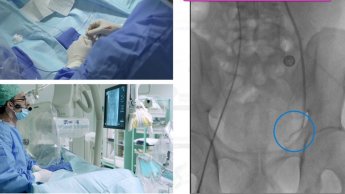Varicoceles
What is a varicocele?
What is a varicocele?
Affecting close to 20 percent of all men, varicoceles are a very common condition in which the testicular veins become enlarged. Patients often experience no symptoms, and the swelling is usually harmless and does not require treatment. However, some patients feel pain or heaviness in the testicles, and the disorder may impact fertility.
What should I know about varicoceles?
Varicoceles occur when the veins along the spermatic cord do not allow sufficient blood flow from the testes to the rest of the body and therefore become dilated, much like a varicose vein in the leg.
In more than 80 percent of cases, varicoceles affect the left side, with varying degrees of severity.
What are the symptoms of varicoceles?
When blood pools in the testicular veins, the resulting swelling can cause the following symptoms:
- Pain in the testes, usually more noticeable on the side affected by the varicocele
- A sensation of heaviness, which intensifies at the end of the day or in hot weather
- Shrinkage of the testes
Some varicoceles are asymptomatic and are only discovered during a fertility evaluation following an abnormal semen analysis result or during a routine physical exam.
What are the risk factors for varicoceles?
It is not clear what causes varicoceles.
If a varicocele is detected in an adult aged 30 or above, this generally rules out the possibility of a kidney tumor. Varicoceles can occur at any age. 40 percent of infertile men have a varicocele, but it is impossible to predict whether an adolescent with a varicocele will suffer from impaired fertility.
In asymptomatic adolescents presenting a varicocele, either medical monitoring with particular attention to semen analysis results or immediate treatment may be proposed, depending on the grade and psychological impact of the varicocele.
In symptomatic adolescents with a high-grade varicocele, abnormal semen analysis result or shrinkage of the testicle(s), immediate embolization treatment is recommended.
How are varicoceles diagnosed at the American Hospital of Paris?
An initial diagnosis may be made based on the history and physical examination of the patient, leading the doctor to order a testicular Doppler ultrasound. The ultrasound, performed during the consultation or by one of the Hospital’s sonographers or vascular specialists, will determine whether a varicocele is present and evaluate its severity and impact on testicle size while eliminating other options in a differential diagnosis.
Varicocele grades range from 0 to 3:
- Grade 0: the varicocele cannot be seen or felt, and can only be detected by ultrasound
- Grade I: the varicocele is not visible but can be felt after a Valsalva maneuver
- Grade II: the varicocele is not visible but can be felt when the patient is standing
- Grade III: the varicocele can be seen and felt without a Valsalva maneuver
What treatments for varicoceles are available at the American Hospital of Paris?
There are no effective natural treatments for varicoceles. In patients with symptoms or an abnormal semen analysis result, treatment is indicated, the least invasive and most effective of which is percutaneous embolization.
This minimally invasive, non-surgical interventional radiology technique consists in inserting a catheter into a vein in the arm, guiding it to the enlarged spermatic vein and occluding the vein using various methods.
The American Hospital of Paris team is one of the few with expertise in the full range of embolization techniques. This allows our doctors to choose the solution most appropriate to each situation based on the patient's anatomy, the size of the varicocele and the embolic agent selected.
Embolization requires only local anesthesia and a short stay in ambulatory care (half a day). Patients can return home just one hour after the procedure. The scar is the same as that of a routine blood draw.
Le traitement des varicocèles par embolisation en images

